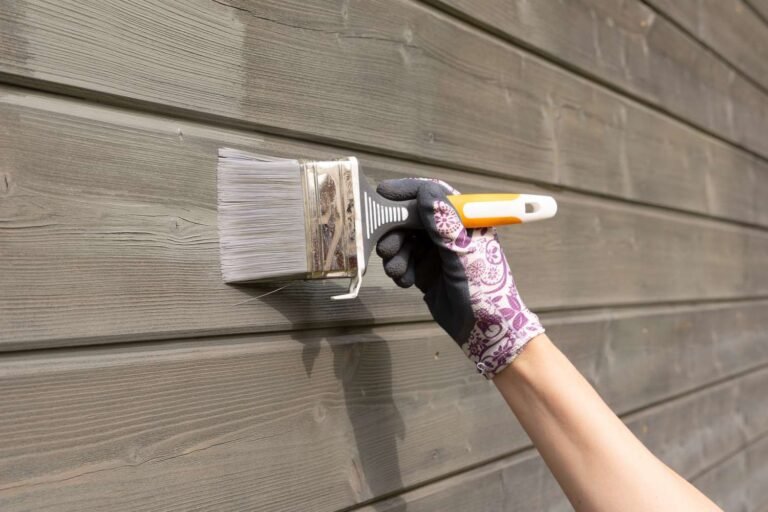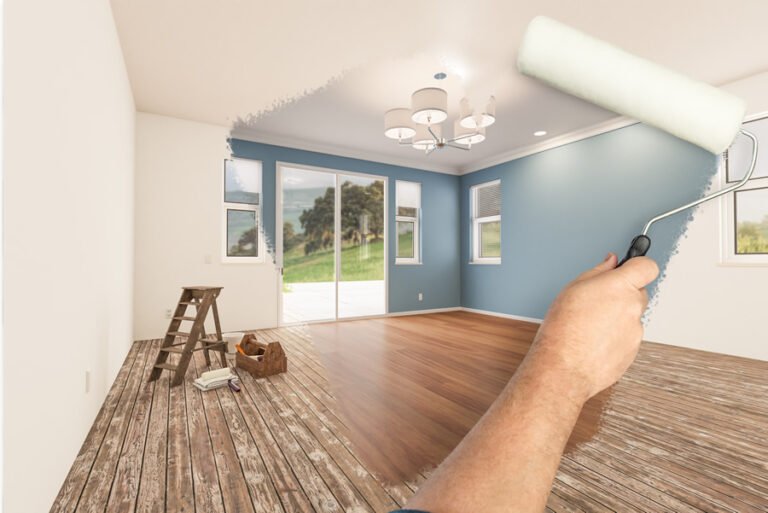The most popular interior paint color right now is sage green stands out as the most popular interior paint color. Its soft, calming tone with gray and blue undertones makes it perfect for nearly every room, from cozy bedrooms to open kitchens. In 2025, Sherwin-Williams selected “Quietude,” a tranquil sage shade, as their Color of the Year. Its rise in popularity isn’t just about aesthetics sage green also supports a peaceful atmosphere, blending beautifully with warm neutrals, natural wood, and soft whites.
Paint manufacturers analyze global design trends, consumer behavior, and color psychology data to predict popular colors. Major brands like Sherwin-Williams, Benjamin Moore, and Behr release annual Color of the Year selections based on extensive market research.
What Makes Sage Green So Popular in 2025?
Sage green combines calming properties with versatility across different room types. This gray-green shade works in bedrooms, kitchens, living rooms, and bathrooms. Interior designers Kelly Sutherland and Lisa Morton recommend sage green for homeowners who want color without overwhelming brightness.
Sage green pairs with multiple color families:
- Warm browns and creams
- Cool blues and whites
- Rich burgundy and coral tones
- Natural wood finishes
Color psychology research shows green reduces stress and promotes relaxation. The European Journal of Theoretical and Applied Sciences published studies confirming color impacts physical and emotional well-being in interior spaces.
Which Paint Colors Are Trending Besides Sage Green?
Brown paint colors rank second in popularity for 2025 interior design. Benjamin Moore’s Cinnamon Slate (2113-40) features heathered plum and velvety brown tones. These browns differ from early 2000s yellow-browns, offering complex undertones that feel modern.
Popular brown paint colors include:
- Benjamin Moore Carob AF-160 (deep mauve-brown)
- Benjamin Moore Fallen Timber 994 (olive-green undertones)
- Sherwin-Williams Hot Cocoa (chocolatey-mauve)
- Farrow & Ball London Clan No. 244 (terracotta-brown)
Deep blue shades rank third among trending colors. Valspar’s Encore represents the saturated blue trend. Dutch Boy selected Mapped Blue (429-5DB), a medium blue-gray with yellow undertones.
How Do You Choose Paint Colors for Different Rooms?
Living rooms benefit from warm neutrals and accent walls with trending colors. Paint one wall in sage green, brown, or deep blue. Keep remaining walls in warm whites like Swiss Coffee or Alabaster.
Kitchen paint colors focus on durability and light reflection. Off-white tones work best for main surfaces. Add trending colors through:
- Cabinet paint in sage green or navy blue
- Island paint in contrasting colors
- Backsplash areas with bold accent colors
Bedroom colors prioritize sleep quality and relaxation. Sage green promotes calm sleep patterns. Warm browns create cozy atmospheres. Avoid bright colors like yellow or orange in sleeping areas.
Bathroom paint requires moisture-resistant formulas. Light sage green works in small bathrooms. Deep blues suit larger master bathrooms. Warm whites reflect light effectively in windowless bathrooms.
What Paint Colors Should You Avoid in 2025?
Cool gray paint colors are declining in popularity. Interior designers report client preferences shifting toward warmer color palettes. Gray-based neutrals feel cold compared to brown-based alternatives.
Stark white paint appears too clinical for modern homes. Warm whites with subtle undertones provide better alternatives:
- Benjamin Moore Alabaster SW 7008
- Sherwin-Williams Pure White SW 7005
- Benjamin Moore Swiss Coffee OC-45
Bright yellow paint overwhelms most interior spaces. Use yellow sparingly as accent colors on doors, trim, or small furniture pieces.
Should You Hire Professional Painters or DIY?
Professional painters handle 29% of residential painting projects in 2025. According to Forbes industry analysis, 70% of homeowners who hire professionals plan to use them again within one year.
Professional painting works best for:
- Multi-room color schemes
- High ceilings and difficult access areas
- Complex color combinations
- Large surface areas requiring consistent coverage
DIY painting suits smaller projects:
- Single accent walls
- Small bathrooms or closets
- Furniture refinishing
- Touch-up work
Professional painters average $3-6 per square foot for interior work. DIY projects cost $1-2 per square foot for materials only.
How Do You Test Paint Colors Before Committing?
Paint large test samples measuring 2×2 feet minimum on actual walls. Small paint chips cannot show how colors appear under different lighting conditions. Natural light changes throughout the day, affecting color appearance.
Testing steps include:
- Paint samples on different wall surfaces
- Observe colors in morning, afternoon, and evening light
- Check appearance under artificial lighting
- Compare colors with existing furniture and decor
- Live with samples for 3-7 days before deciding
LED lighting affects color perception differently than incandescent bulbs. Warm LED lights (2700K-3000K) make colors appear warmer. Cool LED lights (4000K-5000K) make colors appear cooler and brighter.
What Are the Health Benefits of Popular Paint Colors?
Sage green reduces eye strain and lowers blood pressure. Medical studies show green wavelengths have calming physiological effects. Hospital rooms painted in soft greens report faster patient recovery times according to research published by the National Center for Biotechnology Information.
Brown paint colors increase feelings of security and stability. Earth tones connect humans to natural environments. Psychological research links brown interiors with reduced anxiety levels.
Blue paint improves focus and concentration. Studies show blue environments enhance cognitive performance. Home offices painted in deep blues report increased productivity.
How Much Does Professional Interior Painting Cost?
Interior painting costs range from $1,200-$4,000 for average-sized rooms. Factors affecting price include:
- Room size and ceiling height
- Surface preparation requirements
- Paint quality and brand selection
- Number of colors used
- Geographic location
Premium paint brands cost $50-80 per gallon. Standard paint brands cost $25-45 per gallon. Professional labor adds $25-50 per hour depending on local market rates.
Eco-friendly paint options cost 10-20% more than standard formulas. Low-VOC and zero-VOC paints reduce indoor air pollution. The Environmental Protection Agency confirms VOC reduction improves indoor air quality, supporting the global eco-paint market that reaches $11.17 billion in 2025, growing 6.9% annually.
What Paint Finishes Work Best with Trending Colors?
Eggshell finish works best for sage green wall paint. This finish provides subtle sheen while hiding minor wall imperfections. Eggshell reflects enough light to prevent colors from appearing too dark.
Satin finish suits brown paint colors in high-traffic areas. Hallways, living rooms, and dining rooms benefit from satin’s durability and easy cleaning properties.
Semi-gloss finish works for deep blue accent walls. Higher sheen levels make bold colors appear more vibrant. Semi-gloss suits feature walls and architectural details.
Flat finish works only in low-traffic bedrooms and ceilings. This finish shows every mark and cannot be cleaned easily.
Which Paint Brands Offer the Best Color Selection?
Sherwin-Williams offers over 1,500 color options in their ColorSnap system. Their 2025 Color Capsule features nine trending colors including Quietude sage green.
Benjamin Moore provides 3,500+ color choices through their Color Portfolio app. Their Color Trends 2025 palette emphasizes quietly colorful hues with complex undertones.
Behr Paint offers 2,000+ colors with their ColorSmart system. Their 2025 Color Trends Palette features 16 curated colors including warm neutrals and jewel tones.
Paint brand quality differences:
- Benjamin Moore: Highest pigment concentration, best coverage
- Sherwin-Williams: Good durability, wide contractor availability
- Behr: Budget-friendly, good DIY options
- Valspar: Balanced performance and price
Final Thoughts
Sage green dominates 2025 interior paint trends, followed by warm browns and deep blues. These colors reflect consumer preferences for nature-inspired, calming environments. Paint selection affects both visual appeal and psychological well-being in living spaces.
Professional painters handle complex color schemes effectively, while DIY projects work for simple applications. Test all colors extensively before final decisions. Quality paint and proper application create lasting results that enhance home value.Ready to transform your space with trending paint colors? Contact us for professional interior painting services that deliver expert results.




